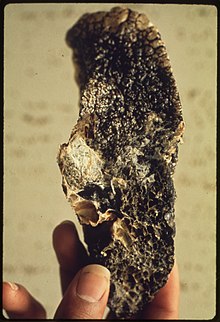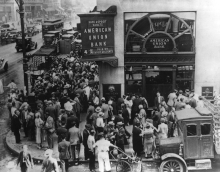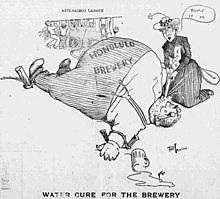Federal Writers' Project – Life Histories/2021/Spring/105i/Section 24/Jim Lauderdale
Overview
[edit | edit source]Jim Lauderdale was a bootlegger in Alabama during the Great Depression. Jack Kytle interviewed Lauderdale on August 8th 1939 for the Federal Writers' Project in Talladega Springs, Alabama.[1]
Biography
[edit | edit source]Working and Personal Life
[edit | edit source]Jim Lauderdale was born on an unknown date in Alabama. Lauderdale married a woman named Ora.[2] Lauderdale began working at Hope's Quarry where he made $35 a month. In Lauderdale's interview with the Federal Writers' Project, he claims that the amount of money he made did not satisfy his wife.[3] He lost his job at Hope's Quarry due to Ora spreading rumors about the owner, Mister Hope.[4]
Lauderdale then began to work in the Red Diamond Mines where he guarded the convicts that the State forced to work in the mines. He started out making $60 a month and his wage was increased to $65 when he began guarding the convicts.[5] The guards were instructed to shoot convicts if they got rough or tried to run-off. Lauderdale never killed anyone but worked with a guard named Giles that had killed several convicts.[6] In his interview he shared a story about a time that Giles handcuffed and beat a convict behind a shed because the convict refused to work.[7]
A month into working at the Red Diamond mines, Lauderdale and his wife had a conflict in which he asked her to stop spending money and as a result she tore up her dresses and destroyed a couch.[8] Ora and Jim Lauderdale had two children together, Dorsett and Zelma. Lauderdale did not have a close relationship with his children. He claimed that his wife "never did want me to git close to either one of 'em" in his interview with Jack Kytle.[9]

Life During the Great Depression
[edit | edit source]Lauderdale worked in the mines for 35 years before he was fired due to his poor health. He had developed a lung condition called Coalworker's pneumoconiosis from the coal dust in the mines.[10] After being fired from the mines, Lauderdale put his savings of $3,000 in a bank in Sylacauga, Alabama that his friend "Ol' Man Mitchum" had recommended. He lost all of his money when the bank failed following the Wall Street Crash of 1929.[11] Lauderdale began to illegally sell alcohol to make money. His bootlegging upset Ora, and he alleges that she was the one who reported him to the police.[12] Lauderdale ended up being arrested and sentenced to time in Kilby Prison.[13]
Shortly after getting out of prison, Lauderdale was fishing with a man named Jess Eatris who came with a bottle of "syrup likker". Lauderdale and Eatris drank the liquor together.[14] Lauderdale returned home drunk and began to fight with his wife. She ran out onto their porch and yelled loudly.[15] The dispute led to him being arrested and fined $5. Following the argument, his wife left him and took many of his possessions.[16] She moved to Sylacauga to live with their daughter, and they both worked in a mill.[17] Lauderdale and his wife had lived together for 45 years before the separation.
Lauderdale struggled with alcoholism, and his health was negatively impacted as a result.[18] Jim Lauderdale died on an unknown date.
Social Issues
[edit | edit source]The Wall Street Crash of 1929 and Bank Runs
[edit | edit source]
During the 20s most of the money that flowed through Wall Street was from stock speculations. Speculators bought stocks as short-term investments and only sought to make profits for themselves. Working class people would withdraw their life savings and invest in stocks. It was very easy for people to buy stocks because they were given loans and only needed a 10% downpayment to purchase the shares.[19] Groups of investors would group together and buy large amounts of one stock to raise the value drastically and trick the public into buying the stock; Then the investors would sell their shares all at once to make large profits.[20] Some companies would print extra shares and sell them or even create new companies to buy shares between each other and inflate the price.[21] All of these issues created a weak foundation for the stock market and a large sale of stocks made the public panic and rush to sell their speculated stocks leading to the market crash on October 29, 1929.[22]
People could not pay back their low-margin loans to bankers after the crash. Since banks had given out too many risky loans they had less money to give to depositors that tried to withdraw money from their savings accounts.[23] Bank runs would happen when large numbers of depositors would all try to withdraw their funds at once, usually due to rumors of a bank's instability. Banks usually only held a fraction of deposits in cash and they would either lend out the rest to borrowers or use it to purchase interest-bearing assets. During a bank run, banks would have to quickly liquidate loans and sell assets to have the available cash. Banks were forced to sell most of their assets at very low prices and this led to large losses. The losses often led to the bank's failure. The first four banking panics began in the fall of 1930. Similar panics followed in the spring and fall of 1931 and the fall of 1932.[24] "Between 1930 and 1933, the nation experienced over nine thousand bank failures"[25] and depositors lost over $140 billion.[26]

The 18th Amendment and Prohibition
[edit | edit source]In 1846, Maine passed the first state prohibition laws and many other states followed in their example.[27] The Anti-Saloon League was founded in 1893.[28] In 1906 the League led attacks on the sale of liquor which was "driven by a reaction to urban growth, as well as the rise of evangelical Protestantism and its view of saloon culture as corrupt and ungodly".[29] Many factory owners also supported prohibition because they wanted to prevent accidents and increase worker efficiency.[30] Other Prohibitionists thought that European immigration would spread "the culture of drinking" in the United States. Women also became involved in the Temperance Movement and they formed the Women's Christian Temperance Union.[31]

In 1917, Congress submitted the 18th Amendment, which prohibited the sale, manufacture, and transportation of alcohol, for state ratification. The amendment was ratified on January 16, 1919. By 1919 at least 33 states had already passed their own prohibition laws. The National Prohibition Act, also known as the Volstead Act, was introduced in October 1919 and gave guidelines for the enforcement of prohibition by the federal government.[32]
Prohibition led to the rise in illegal manufacture and distribution of alcohol. People began to make their own alcohol, also known as bootlegging, operate speakeasies, and smuggle alcohol across borders. "Throngs of Americans who regarded Prohibition as a joke or an injustice became enmeshed in crime for the first time."[33] Prohibition made gangsters like Al Capone able to make millions in profits from bootlegging and speakeasies. As a result of the increase in criminal activity and gang violence, support for Prohibition fell. In 1933 the 21st Amendment was ratified and it ended Prohibition.[34]
Notes
[edit | edit source]- ↑ Interview of Jim Lauderdale by Jack Kytle 1939, in the Federal Writers' Project papers #3709, Southern Historical Collection, The Wilson Library, University of North Carolina at Chapel Hill.
- ↑ Ibid., 5.
- ↑ Ibid., 6.
- ↑ Ibid., 7.
- ↑ Ibid., 7.
- ↑ Ibid., 8.
- ↑ Ibid., 10.
- ↑ Ibid., 11.
- ↑ Ibid., 12.
- ↑ Ibid., 15.
- ↑ Ibid., 2.
- ↑ Ibid., 4.
- ↑ Ibid., 5.
- ↑ Ibid., 16.
- ↑ Ibid., 17.
- ↑ Ibid., 18.
- ↑ Ibid., 1.
- ↑ Ibid., 19.
- ↑ Feinberg, Barbara Silberdick and Inc NetLibrary. 1995. Black Tuesday: The Stock Market Crash of 1929. Brookfield, Conn: Millbrook Press., 25.
- ↑ Ibid., 26.
- ↑ Ibid., 27.
- ↑ Ibid., 31.
- ↑ Ibid., 33.
- ↑ History.com Editors. "Bank Run". 2019. HISTORY.
- ↑ Shaw, Christopher W. "Banks of the People": The Life and Death of the U.S. Postal Savings System." Journal of Social History 52, no. 1 (2018): 121-152.
- ↑ Ganzel, Bill. 2003. "Bank Failures During The 1930S Great Depression".
- ↑ History.com Editors. "Prohibition". 2020.
- ↑ Watts, Duncan. "Prohibition (or Temperance) Movement." In Dictionary of American Government and Politics. Edinburgh University Press, 2010.
- ↑ History.com Editors. "Prohibition". 2020.
- ↑ Ibid.
- ↑ Watts, Duncan. "Prohibition (or Temperance) Movement." In Dictionary of American Government and Politics. Edinburgh University Press, 2010.
- ↑ History.com Editors. "Prohibition". 2020.
- ↑ Funderburg, "Everybody's Doing It: Breaking the Law for Fun and Profit," Bootleggers and Beer Barons of the Prohibition Era. Jefferson, NC: McFarland, 2014.
- ↑ History.com Editors. "Prohibition". 2020.
References
[edit | edit source]- Feinberg, Barbara Silberdick and Inc NetLibrary. 1995. Black Tuesday: The Stock Market Crash of 1929. Brookfield, Conn: Millbrook Press.
- Funderburg, J. Anne. Bootleggers and Beer Barons of the Prohibition Era. Jefferson, NC: McFarland, 2014. https://library-biblioboard-com.libproxy.lib.unc.edu.
- Ganzel, Bill. 2003. "Bank Failures During The 1930S Great Depression". Livinghistoryfarm.Org. https://livinghistoryfarm.org/farminginthe30s/money_08.html.
- History.com Editors. "Bank Run". 2019. HISTORY. https://www.history.com/topics/great-depression/bank-run
- History.com Editors. "Prohibition". 2020. HISTORY. https://www.history.com/topics/roaring-twenties/prohibition.
- Interview of Jim Lauderdale by Jack Kytle 1939, in the Federal Writers' Project papers #3709, Southern Historical Collection, The Wilson Library, University of North Carolina at Chapel Hill.
- Watts, Duncan. "Prohibition (or Temperance) Movement." In Dictionary of American Government and Politics. Edinburgh University Press, 2010. http://libproxy.lib.unc.edu/login?url=https://search.credoreference.com/content/entry/eupamgov/prohibition_or_temperance_movement/0?institutionId=1724
- Shaw, Christopher W. "Banks of the People": The Life and Death of the U.S. Postal Savings System." Journal of Social History 52, no. 1 (2018): 121-152. muse.jhu.edu/article/702774.